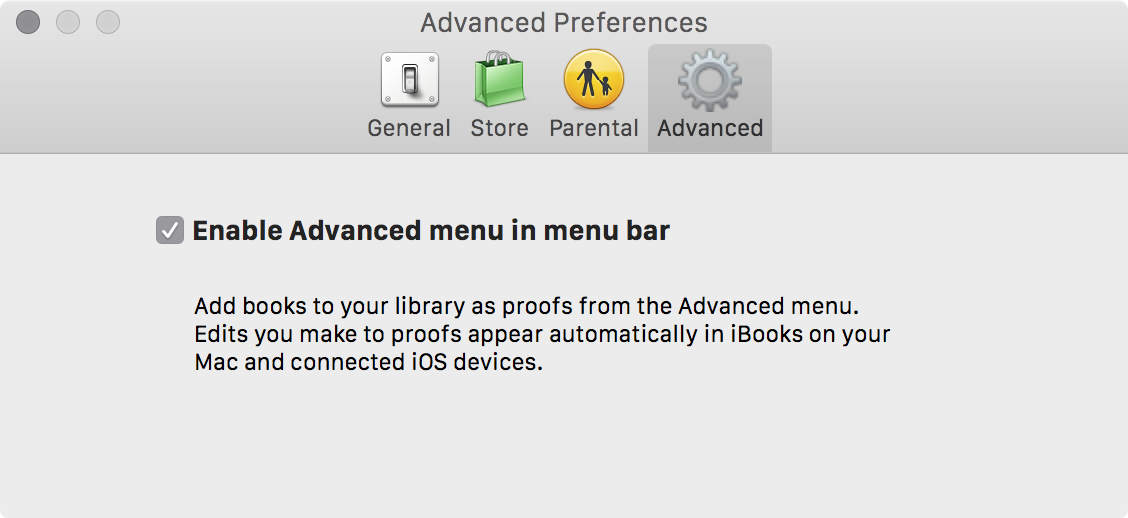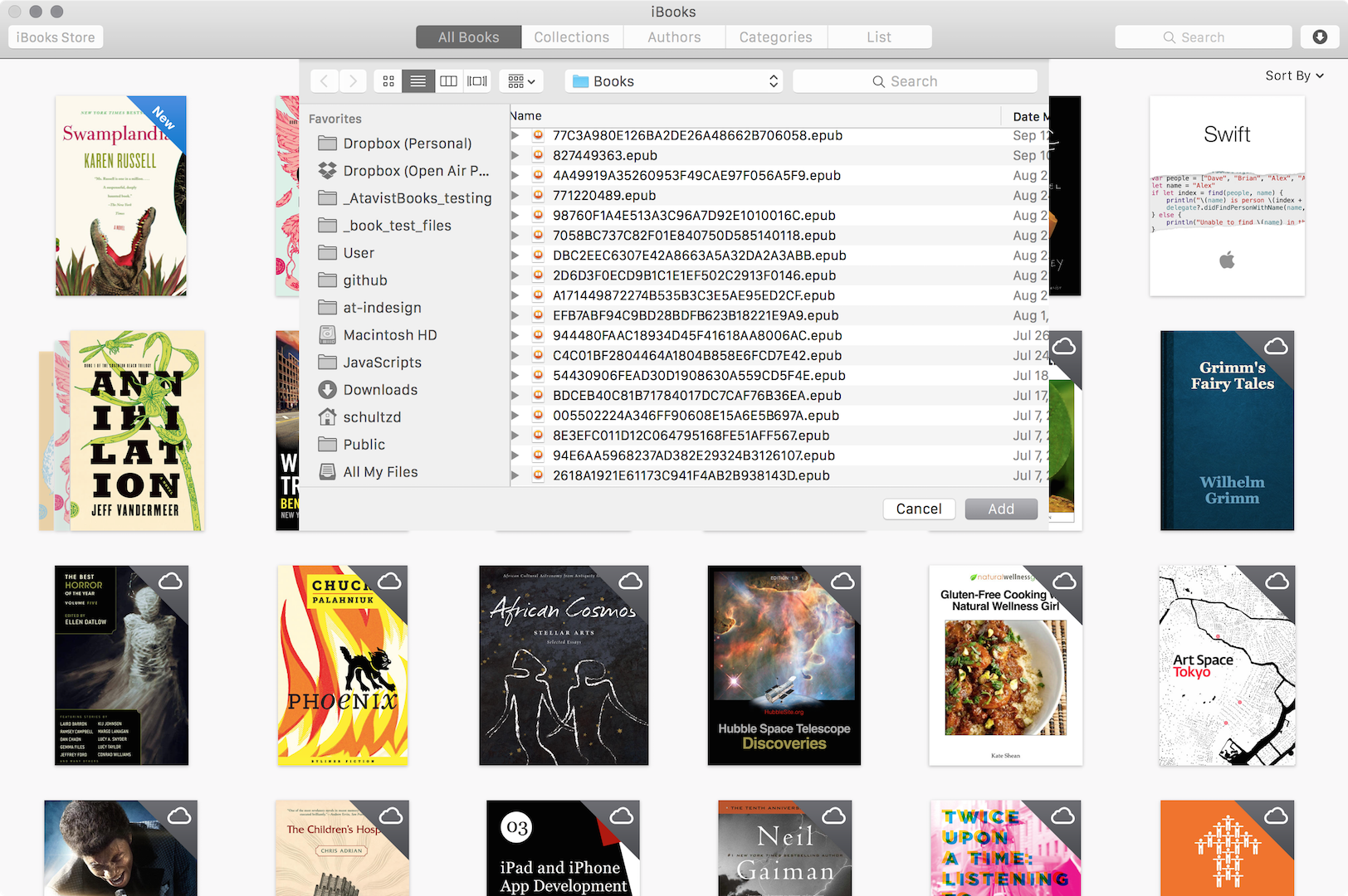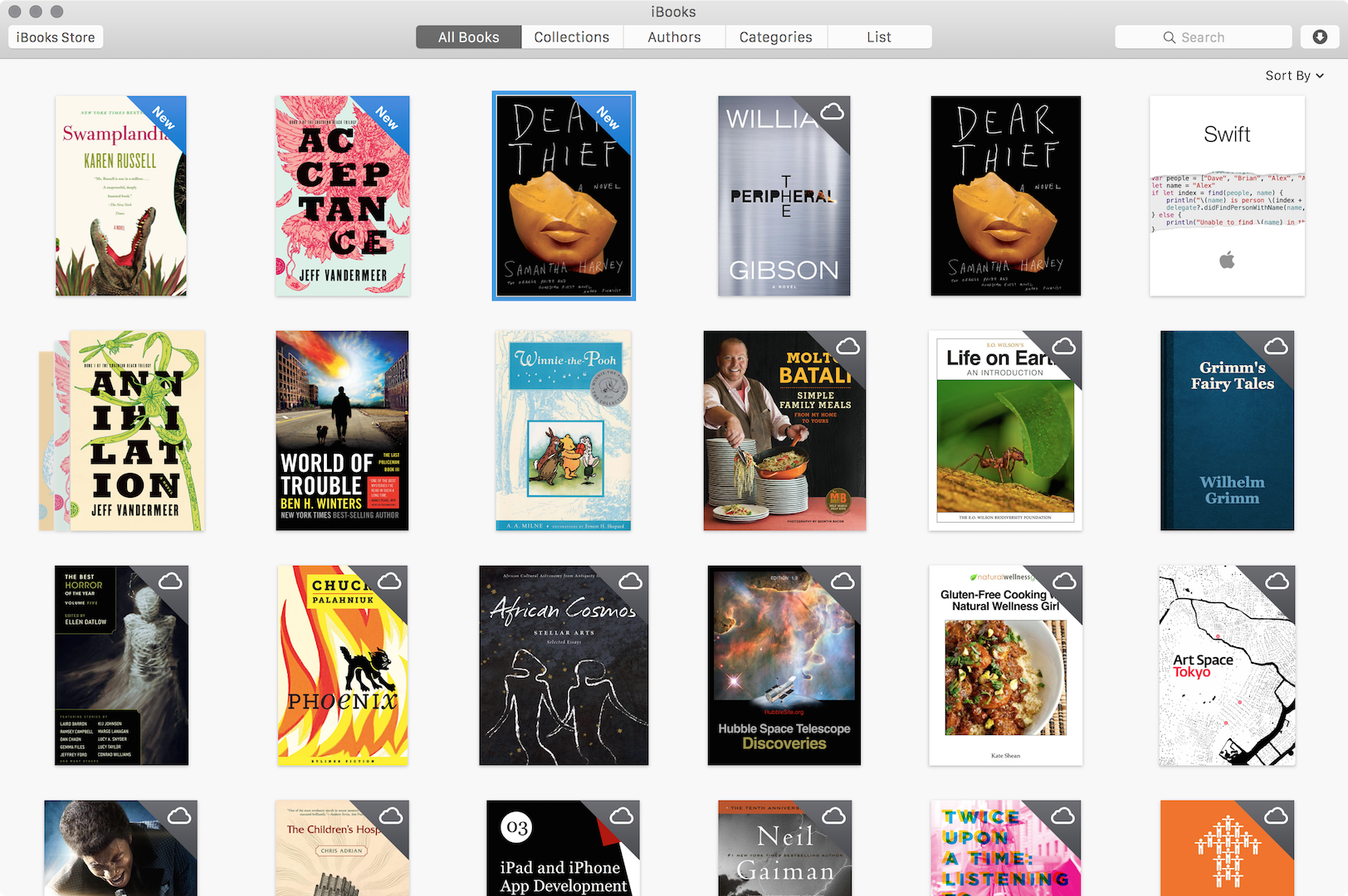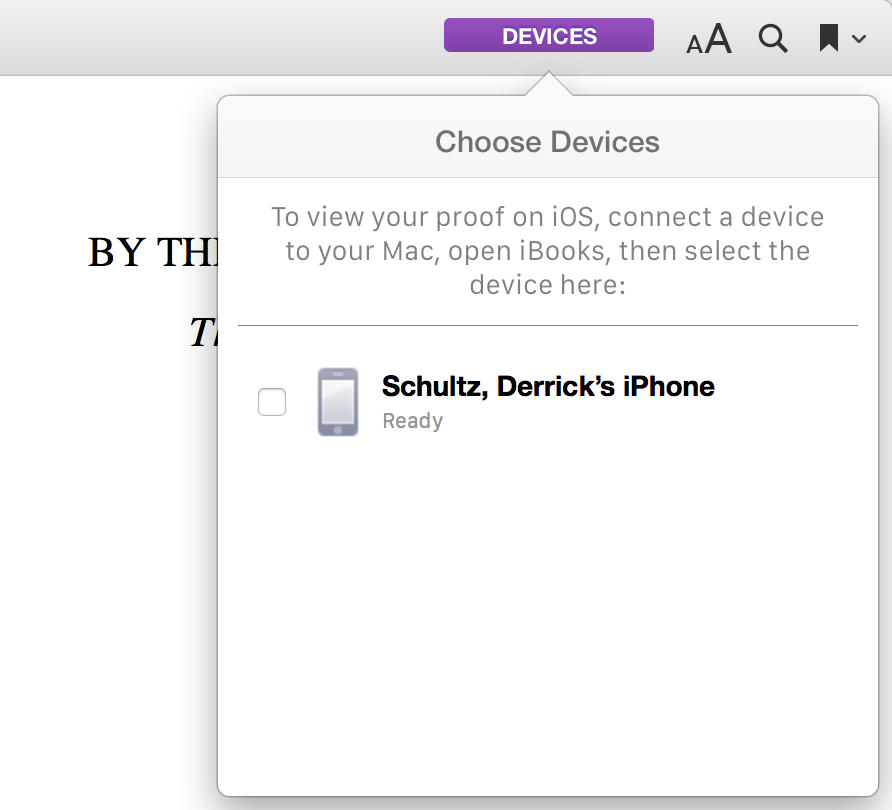New book proofing tool in iBooks for OS X Yosemite
Prior to OS X Yosemite, Apple had a standalone app called Book Proofer that EPUB producers could use to test EPUB files on iOS Devices. Since Yosemite, however, the Book Proofer app has had issues syncing with iOS.
Today with the release of iBooks Asset Guide 5.2Rev2 (available to users who have access to the iBookstore in iTunes Connect) there’s a new way that will work in Yosemite. Here’s how to easily sync and proof books on iOS devices with OS X Yosemite.
Enable the Advanced Menu Bar
The first step is to open the desktop iBooks app and open the Preferences menu. Then click on the Advanced tab. Check the checkbox labeled “Enable Advanced menu in menu bar.”
Add an EPUB to iBooks Desktop
Once the Advanced menu bar has been added, you can select Advanced, then “add ePub to Library as Proof…”
Here’s the biggest catch I’ve found with this process so far. Currently, I can’t seem to add just any .epub file I want. I can only add epub files already put into the iBooks folder on my OS X machine (you can find this folder by navigating to USERNAME>Library>Containers>com.apple.BKAgentService>Data>Documents>iBooks>Books). EPUB files outside of this folder will be grayed out and unselectable, but files within this folder can be added. (To make matters worse, these titles are often given very arbitrary names!) Hopefully this is resolved in future updates…
Select the book you want and it will be added to OS X iBooks. (The Asset Guide says these will be marked with a “Proof” label. Mine are only marked as “New” however.)
Sync to iOS Device
Once you’ve added a book to iBooks in Yosemite, it’s time to sync it to an iOS Device. Plug the device into your computer and open iBooks on the iOS device, and then open the book in iBooks Desktop. Once open you’ll see a new button in the upper right hand corner that is labeled “Devices.” Click this to reveal a list of devices connected to your desktop machine.
Check the box for the device you want synced with the book proof. The book will load on the device and add the label of “Proof” to it.

Notice the book toward the bottom with the purple label “Proof” (I have no idea why it loaded in the middle).
Now you can proof the book on the device.
Is it Worth It?
I remain unconvinced this is the easiest way to proof a book in iBooks. The issues with folder access seems the biggest dealbreaker. My previously written about Dropbox method seems far more efficient. I know some ebook producers swear by the previous Book Proofer app and its cache-breaking capabilities, so if you’re one of those you may find this new feature for Yosemite a welcome addition. Me, I’ll just scratch my head and keep using Dropbox.





Excellent info! I downloaded the updated guide but hadn’t cracked it open yet.
Is Apple serious? It wants me to place an epub to be proofed in:
USERNAME>Library>Containers>com.apple.BKAgentService>Data>Documents>iBooks>Books
Just navigating there would take about a minute and require keeping around a scrap of paper listing all those subfolders. I’ve got better things to do with that time.
This also illustrates that Apple’s iCloud conundrum continues. It almost seems like Apple intends make iCloud a nuisance, so we grow to hate it and label it the “Worst Cloud Service Evah.” In comparison to Dropbox, it is.
1. For applications where iCloud would be helpful Apple either requires USB synch instead (as here), or buries the folder that links via the cloud deep within an obscure series of folders. Why isn’t there simply an iCloud folder with subfolders for various uses?
All I need to do to read PDFs in the Dropbox app on all my Dropbox-synched devices is place them in an easily located Dropbox folder of my own choice. To make iClouds work right Apple could have an easy-to-locate, auto-synched folder in a sensible place. What goes into that folder can be synched between all our Macs and iDevices, and accessible in iBooks from each. That’s not rocket science.
2. For applications where iCloud isn’t wanted, Apple tries to cram it down our throats. The very name of the Preview app tells its purpose. It’s for a quick look at a file. And yet for Preview Apple tries to force iCloud synching. As far as I know, we can’t even turn off the bugging us about that. That’s dumb, really dumb.
To the extent that these two conflicting policies make any sense, they suggest that Apple thinks their typical user is stupid—really, really stupid. Certain features of iCloud are hid like they hid the Library folder—because Apple thinks we are too stupid to not mess them up. Certain other features are crammed down our throat because again, we’re too stupid in Apple’s eyes manage to remember something as simple as saving files we want to save. But Apple’s solicitude for the stupidest 2% is making life a pain for the rest of us.
I’m especially ticked off about Book Proofer. I’ve often pointed to it as an illustration of how Apple treats authors better than Amazon. That’s why Apple needs to fix Book Proofer for Yosemite. It worked marvelously and updated epubs in seconds every time I saved a revised epub from InDesign. It even went to the same page, saving more time. It was marvelous. This utterly dreadful, klungy, clumsy, every done manually iBooks synching doesn’t replace that.
Heck, when you can’t even copy a competitor who’s done it right—as Dropbox has—you’re in really bad shape.
I found that you can have the epub live anywhere, just take the folder of the unzipped epub and .epub to the file. Then choose that one when you go to add an epub to your library. In the finder take and right click for show contents of folder, then when you edit an xhtml file in that folder via whatever you use, it will update live within seconds. I actually found it quicker then proofer.
Erik
Having to go through both iBooks and iTunes is far clunkier than using the standalone Book Proofer app. I’ll try Erik’s solution once I upgrade to Yosemite. Sadly, looks like Book Proofer is being left behind.
Actually using iBooks in Yosemite for proofing offers the same capabilities as the Proofer had, and is simpler.
All you have to do is add an .epub extension to your epub folder name, then you can add it to iBooks as proof from anywhere.
You can update individual files within the epub folder and proof instantly.
However note that a folder with an extension is seen as a file (more precisely package) by OS X and some editors may have troubles opening files within such packages. I use Brackets, which is for free, simple, yet very powerful.
Hate that. Now you have to use Yosemite, which is not stable enough in a production environment, and I’ve been trying hard since the developers’ beta but it won’t do as is because of gigantic bugs, and the Book Proofer becomes deeply linked to system updates, which is so bad of an idea that it should not have been designed like this in the first place—that’s “programming 010”.
In other words, you have iOS 8 but not Yosemite, you’re screwed: waste your time using the cloud or emailing files because iTunes can’t deal with iBooks’ cache.
And no, in my experience, when you were using iBooks Proofer to the max of its capabilities, this new way isn’t better, it’s dimensions worse. Once you understood that it dealt with folders way better than with .epub files, it was just blazingly fast and useful. And there was no clutter in your freaking way, you were in the zone.
It’s time developers give a f*€k and stop saying Amen to big companies. Know what? Saying amen has always resulted in a collapse. It’s time we tell some developers they are clowns who don’t know what they are talking about (that’s how Adobe’s guys and Google guys are considered in Europe, you can trust me, it popped as a surprise when I landed there) or parasites whose actions are hurting standards. It takes some guts and if you don’t have those guts, well, we are going to keep on going without american developers as we will start seeing them as accomplices.
My two cents. Really. You don’t know how much people are angry in Europe—half of platforms won’t even accept EPUB 3 because of ID’s code mess—and that may become a blood bath very shortly. And those people are going to want parasites gone if need be, believe me.
PS: and if you don’t believe me, please consider that they are currently talks among some developers to decide if there is a need to start a petition asking Adobe to fire people who have been working on ID’s epub export. Period.
Thanks Derrick and Erik.
The New way seems to update quicker and to be more stable than iBookproofer. And one can check on the mac and the iPad simultaneously.
Using Eriks Method makes it pretty easy working.
Everything is very open with a precise explanation of the issues.
It was really informative. Your site is very helpful.
Thanks for sharing!
The method won’t work for me. My devices don’t show up in the ‘devices’ menu. Running iBooks 1.7 on macOS 10.12.1 and iOS 10.1.1